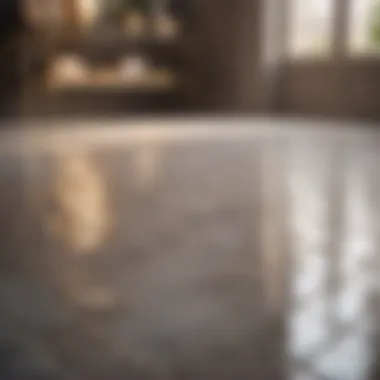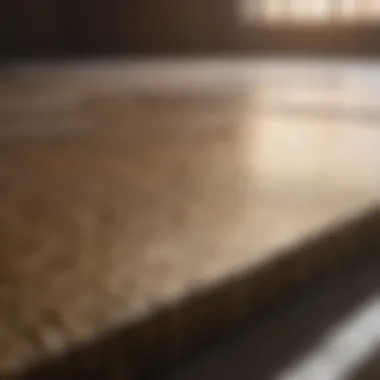Materials:
- Tile grout powder (exact measurement: 5 pounds)
- Water (exact measurement: 2.5 quarts)
- Grout float
- Grout sponge
- Bucket
- Measuring cup
- Protective gloves
- Dust mask
- Sealer
DIY Steps:
- Prepare the grout mixture by combining 5 pounds of tile grout powder with 2.5 quarts of water in a bucket. Mix thoroughly until a smooth consistency is achieved.
- Apply the grout using a grout float, pressing it into the spaces between the tiles at a 45-degree angle.
- Wipe off excess grout with a damp grout sponge at a 90-degree angle to the tiles.
- Allow the grout to set for 15-30 minutes, then wipe the tiles again with a clean, damp sponge.
- After 24 hours, apply a sealer to protect the grout and enhance its longevity.
Technical Aspects:
- Tools: Grout float, grout sponge, bucket, measuring cup
- Timing: Allow 15-30 minutes for grout setting
- Critical Techniques: Press grout in at a 45-degree angle, wipe off excess at a 90-degree angle
DIY Project Process:


- Mix grout to the specified measurements
- Apply grout methodically with a float
- Clean excess grout with a damp sponge
- Allow for proper setting time
- Seal the grout after 24 hours
Troubleshooting Tips:


- If the grout is too runny, add more powder; if too thick, add water gradually
- Ensure all excess grout is removed before it sets
- Use a high-quality sealer for best results
Understanding Grout and Its Significance


In the realm of tiling, grout plays a pivotal role that encompasses both functional and aesthetic aspects, making it a critical element in the overall finish of a tiled surface. Understanding the different types of grout and their significance is essential for achieving the desired outcomes in a tiling project. Grout acts as a binding agent that not only fills the gaps between tiles but also enhances the structural integrity of the surface, ensuring durability and longevity. By comprehending the nuances and importance of grout, individuals can elevate the aesthetics and performance of their tiled spaces.
Types of Grout Materials
Sanded Grout
Sanded grout is a versatile and popular option known for its durability and strength. It contains fine sand particles that provide a tougher consistency, ideal for spaces where tiles are exposed to higher traffic or where larger grout lines are present. The rough texture of sanded grout makes it less prone to cracking and shrinking, offering robust support to the tiles. However, its coarse nature may not be suitable for thin grout lines or polished tiles, as it can potentially scratch the surface. Nevertheless, for areas that require added strength and support, sanded grout stands out as a reliable choice.
Unsanded Grout
On the other hand, unsanded grout is a smoother option made without sand particles, making it ideal for thinner grout lines and more delicate tile surfaces. Unsanded grout is preferred for walls, backsplashes, and areas where the grout lines are less than an eighth of an inch wide. Its finer texture allows for a smoother application and is less likely to scratch or damage tiles during the grouting process. While unsanded grout offers a polished and neat finish, it may lack the same level of strength and resistance to cracking compared to sanded grout.
Epoxy Grout
Epoxy grout represents a high-performance grouting solution known for its exceptional durability and resistance to stains, chemicals, and water. This type of grout is composed of epoxy resins and hardeners, creating a waterproof and non-porous finish that is ideal for areas prone to moisture and spills, such as kitchens and bathrooms. Epoxy grout is available in a wide range of colors, offering versatility in design choices. Despite its premium qualities, epoxy grout can be challenging to work with due to its quick-drying nature, requiring precision and efficiency during application. Its exceptional properties make epoxy grout a popular choice for demanding environments where longevity and protection are paramount.
Importance of Grout in Tiling
Grout serves multiple essential functions beyond mere aesthetics in a tiling project, making it a crucial component that significantly impacts the overall outcome. Understanding the significance of grout in tiling goes beyond filling gaps; it contributes to the stability and longevity of the tiled surface.
Aesthetic Enhancement
The aesthetic role of grout in tiling cannot be overstated, as it has the power to elevate the visual appeal of a tiled surface significantly. Grout color selection can either complement or contrast with the tiles, influencing the overall design aesthetic. Contrasting grout can accentuate individual tiles, creating a bold and dynamic look, while matching grout can produce a cohesive and seamless appearance. Additionally, grout lines help define the pattern and layout of tiles, contributing to the overall visual impact of the tiled surface.
Structural Stability
Beyond aesthetics, grout plays a critical role in enhancing the structural stability of a tiled surface. By filling the gaps between tiles, grout prevents movement, minimizes the risk of tiles shifting or cracking, and reinforces the entire surface structure. Properly applied grout ensures that tiles remain securely in place, even in high-traffic areas or environments prone to vibration or abrupt movements. The stability provided by grout not only enhances the longevity of the tiled surface but also reduces the need for frequent repairs or replacements, making it a cost-effective and practical investment in tiling projects.
Prevention of Water Damage
One of the primary functions of grout in tiling is to prevent water penetration and protect the underlying surfaces from moisture damage. Sealing the grout helps create a barrier against water infiltration, preventing seepage into the subfloor or walls. In areas exposed to water, such as showers, bathrooms, or kitchens, adequate grouting and sealing are essential to maintain the integrity of the tiled surface and prevent issues like mold growth, rot, or structural deterioration. Properly maintained grout acts as a safeguard against water-related damage, prolonging the life of the tiles and ensuring the structural integrity of the entire tiled surface. -.
Preparation Before Grouting
In the extensive process of grouting tiles, the preparation phase holds utmost importance. It serves as the foundation for a successful tile installation, contributing significantly to the final outcome's quality and durability. Adequate preparation ensures that the grout adheres properly, creating a long-lasting bond with the tiles. Some specific elements to consider before grouting include thorough cleaning and drying of the tile surface, meticulous masking to protect adjacent areas, and ensuring proper ventilation to facilitate the grouting process.
Cleaning and Drying Tiles
Removing Debris
When it comes to preparing tiles for grouting, removing debris plays a pivotal role in achieving a smooth and flawless finish. Clearing the tile surface of any dust, dirt, or particles ensures that the grout can effectively bond with the tiles, reducing the risk of imperfections or weak joints. Additionally, removing debris helps in creating a clean canvas for the grout application, enhancing the overall aesthetic appeal and structural integrity of the tiled area.
Proper debris removal involves thorough sweeping, vacuuming, and wiping of the tile surface to eliminate all traces of foreign particles. This meticulous process sets the stage for a seamless grouting experience, allowing the grout to penetrate evenly and securely between the tiles. While removing debris may seem like a simple step, its contribution to the final grouting result should not be underestimated.
Ensuring Proper Ventilation
Maintaining adequate ventilation during the grouting process is crucial for several reasons. Firstly, proper ventilation helps in expediting the drying time of the grout, ensuring efficient curing and hardening. Adequate airflow also aids in dissipating fumes emitted during the grouting process, creating a healthier environment for both the installer and the surrounding residents. Moreover, proper ventilation reduces the risk of moisture buildup, which can impact the grout's setting and overall performance.
To enhance ventilation, it is recommended to open windows, use fans, or establish a cross-ventilation system in the grouting area. This proactive measure not only accelerates the grout drying process but also contributes to a more comfortable and controlled working environment. By prioritizing proper ventilation, individuals can optimize the grouting process and achieve professional results with ease.
Masking and Protecting Adjacent Surfaces
Taping Off Edges
When preparing for grouting, taping off edges is a strategic technique that helps in achieving clean and precise grout lines. By applying painter's tape or masking tape along the edges of the tiled area, individuals can protect adjacent surfaces from accidental spills or splatters during the grouting process. Taping off edges not only ensures a neat finish but also simplifies the cleanup process by containing the grout within the designated tile boundaries.
The key characteristic of taping off edges lies in its ability to create defined borders for the grout application, preventing it from spreading beyond the intended area. This meticulous approach enhances the overall aesthetic appeal of the tiled surface, resulting in sharp and well-defined grout lines. While taping off edges may require additional time and effort, its advantages in achieving professional-looking grout finishes make it a popular choice among meticulous tile installers.
Using Protective Sheets
In addition to taping off edges, using protective sheets further safeguards adjacent surfaces during the grouting process. By laying down disposable plastic or cloth sheets, individuals can provide an extra layer of protection against grout spills or splashes, minimizing the risk of staining or damage to surrounding areas. Protective sheets are particularly beneficial for large tiling projects where the likelihood of grout accidents is higher, offering peace of mind and streamlined cleanup procedures.
The unique feature of using protective sheets lies in their versatility and ease of application. These convenient barriers create a barrier that is easily removed after grouting, leaving behind clean and unaffected surfaces. While protective sheets may exhibit minor disadvantages such as additional cost or waste generation, their role in preventing potential damage to adjacent surfaces remains invaluable in the grouting process.
Mixing and Applying Grout
Mixing and applying grout is a pivotal stage in the process of tile installation, as it determines the overall aesthetic appeal and longevity of the tiled surface. Each step in this process requires meticulous attention to detail and precision to achieve a flawless finish that not only enhances the visual aspect but also ensures the structural integrity of the tiling.
When it comes to mixing and applying grout, it is essential to consider the type of grout being used, the specific requirements of the tiling project, and the desired outcome. By mastering the techniques involved in this process, individuals can elevate the overall quality of their tile installation and prolong its lifespan.
Preparing the Grout Mixture
Consistency Check
Checking the consistency of the grout mixture is a critical step in ensuring that the application process goes smoothly and that the grout adheres effectively to the tile surface. The consistency of the grout should be neither too thick nor too thin, as the wrong consistency can result in a subpar finish or inadequate adhesion.
One key characteristic of performing a consistency check is the ability to achieve a smooth and uniform texture that is easy to spread and work with during application. This ensures that the grout fills the spaces between the tiles evenly, creating a cohesive look and strengthening the overall structure of the tiled surface. By maintaining the ideal consistency, individuals can guarantee a professional-looking result that is both visually pleasing and durable.
Avoiding Lumps
Avoiding lumps in the grout mixture is another vital aspect to consider when preparing for application. Lumps in the grout can disrupt the smooth flow of the grouting process and lead to an uneven finish that detracts from the overall aesthetics of the tiled surface.
One advantageous feature of preventing lumps is the ability to maintain a consistent and uniform texture throughout the grout mixture. By ensuring a smooth and lump-free consistency, individuals can achieve a seamless application that enhances the visual appeal of the tiles and promotes long-term durability.
Application Techniques
Using a Float
Utilizing a float during the grout application process is an effective technique for evenly spreading the grout across the tile surface. A key characteristic of using a float is its ability to push the grout into the spaces between the tiles, ensuring complete coverage and a strong bond between the grout and the tile edges.
One beneficial aspect of using a float is its ergonomic design, which allows for comfortable handling and precise application. The unique feature of a float lies in its rubber base, which helps in smoothing the grout and removing excess material, resulting in a polished and professional finish. By incorporating a float into the application process, individuals can achieve a consistent and uniform grout application that enhances the overall aesthetics of the tiled surface.
Working in Sections
Dividing the tiling area into manageable sections is a strategic approach to grout application that ensures thorough coverage and consistent results. Working in sections allows individuals to focus on small areas at a time, preventing the grout from drying out before completing the application and giving them more control over the process.
One advantageous aspect of working in sections is the ability to maintain a systematic workflow that promotes efficiency and precision. By tackling one area at a time, individuals can ensure that each section receives equal attention and that the grout is applied uniformly throughout the tiled surface. This method minimizes the risk of mistakes and promotes a seamless finish that elevates the overall appearance of the tiling project.
Cleaning Excess Grout
Cleaning excess grout is a critical step in the tiling process, ensuring a pristine and polished finish. In this article, we emphasize the importance of meticulous cleanup to achieve professional results. Properly removing excess grout not only enhances the aesthetic appeal of your tiled surface but also contributes to its longevity and durability. By focusing on cleaning excess grout effectively, you can prevent unwanted residue and blemishes, elevating the overall quality of your tiled area.
Immediate Cleanup
When it comes to immediate cleanup after grouting, two key aspects play a significant role: sponging off excess grout and avoiding haze. Both these steps are crucial in ensuring a clean and flawless finish.
Sponging Off Excess Grout
Sponging off excess grout involves the use of a damp sponge to gently wipe away the surplus grout from the tile surface. This method is highly effective in removing excess grout without disturbing the grout lines. The unique characteristic of sponging off excess grout is its ability to quickly and efficiently clean the tiles, leaving behind a smooth and even grout surface. While sponging off excess grout is a popular choice for immediate cleanup, it is essential to note that excessive pressure might lead to grout removal, requiring careful control during the process.
Avoiding Haze
Avoiding haze refers to the prevention of a dull film left on the tile surface after grouting. This is achieved by ensuring proper sponging techniques and using clean water throughout the cleaning process. The key characteristic of avoiding haze is its ability to maintain the shine and clarity of the tiles, enhancing their overall appearance. By diligently following haze prevention methods, you can preserve the beauty of your freshly grouted tiles and achieve a professional finish. While avoiding haze requires attention to detail, the results significantly contribute to the visual appeal of the tiled surface.
Final Cleaning Stage
As you progress to the final cleaning stage, focus shifts to buffing with a cloth and applying finishing touches to perfect the grouting process.
Buffing with a Cloth
Buffing with a cloth involves using a clean, dry cloth to gently polish the tiled surface, removing any remaining haze or residue. This step enhances the tiles' shine and smoothness, providing a professional and refined finish. The key characteristic of buffing with a cloth is its ability to bring out the natural beauty of the tiles, showcasing their color and texture. While buffing with a cloth adds a final touch of elegance to your tiled area, care must be taken to avoid abrasive materials that could damage the grout or tiles.
Finishing Touches
Adding finishing touches involves inspecting the tiled surface for any imperfections and making final adjustments to ensure a flawless outcome. By paying attention to details such as grout lines, tile alignment, and cleanliness, you can elevate the overall look of your tiled area. The unique feature of finishing touches lies in the precision and finesse applied to achieve perfection. While completing finishing touches may require extra time and effort, the end result is a professionally completed tiled surface that exudes style and sophistication.
Sealing the Grout
In the realm of tiling, the final stage of sealing the grout holds paramount importance as it ensures the longevity and durability of the tiled surface. This section focuses on the meticulous process of sealing the grout, shedding light on its specific elements, benefits, and essential considerations within the context of this comprehensive guide on mastering the application of grout to tiles.
Purpose of Sealing
Waterproofing
Delving into the realm of waterproofing within the context of grout sealing, it becomes evident that this aspect plays a significant role in enhancing the overall integrity and performance of the tiled surface. Waterproofing in sealing the grout involves the application of a protective barrier that safeguards the grout from water infiltration. The key characteristic of waterproofing lies in its ability to prevent moisture penetration into the grout, thereby enhancing its resistance to water damage. This feature makes waterproofing a highly beneficial choice within this article as it not only ensures the longevity of the tiled surface but also mitigates the risk of mold or mildew growth. While the advantages of waterproofing in grout sealing are substantial, it is essential to acknowledge that improper application or inadequate coverage may result in potential disadvantages such as discoloration or compromised effectiveness, emphasizing the need for precise execution.
Enhancing Durability
When considering the aspect of enhancing durability through sealing the grout, one recognizes its fundamental contribution to the overall goal of achieving a flawless and long-lasting tiled surface. The primary characteristic of enhancing durability lies in fortifying the grout, thereby increasing its resistance to wear, staining, and external factors. This quality makes enhancing durability a popular choice within the context of this article as it extends the lifespan of the tiled surface and maintains its aesthetic appeal over time. The unique feature of enhancing durability through grout sealing lies in its ability to create a protective shield that shields the grout from daily usage and external aggressors. While the advantages of enhancing durability are significant, it is crucial to note that improper application or neglecting resealing may lead to potential disadvantages such as diminished effectiveness or increased maintenance requirements, underlining the importance of following recommended practices.
Sealing Process
Choosing the Right Sealer
The process of choosing the right sealer for grout sealing is a critical step that influences the overall outcome and performance of the tiled surface. Selecting an appropriate sealer involves considering factors such as the type of grout, desired level of protection, and environmental exposure. The key characteristic of choosing the right sealer lies in its ability to provide the necessary level of protection without altering the appearance or texture of the grout. This feature makes choosing the right sealer a beneficial choice within this article as it ensures compatibility and effectiveness in preserving the integrity of the grout. The unique feature of selecting the right sealer lies in the variety of options available, including penetrating sealers, enhancing sealers, and natural look sealers, each offering specific benefits and considerations. While the advantages of choosing the right sealer are notable, it is essential to exercise caution and follow manufacturer guidelines to prevent disadvantages such as improper sealing or inadequate coverage, emphasizing the importance of informed decision-making.
Application Instructions
The application instructions for grout sealing mark the final stage in the process, culminating in the protection and enhancement of the tiled surface. Following precise application instructions is crucial for ensuring thorough coverage and optimal performance of the sealer. The key characteristic of application instructions lies in providing clear guidance on preparation, application techniques, and curing times to achieve the desired results effectively. This quality makes application instructions a popular choice within this article as it empowers individuals to seal their grout with precision and confidence. The unique feature of application instructions lies in the tailored recommendations offered by sealer manufacturers, addressing specific grout types and environmental conditions. While the advantages of application instructions are significant, it is imperative to adhere to the provided guidelines to avoid potential disadvantages such as streaking, over-application, or uneven finish, highlighting the necessity of attention to detail and adherence to best practices.





